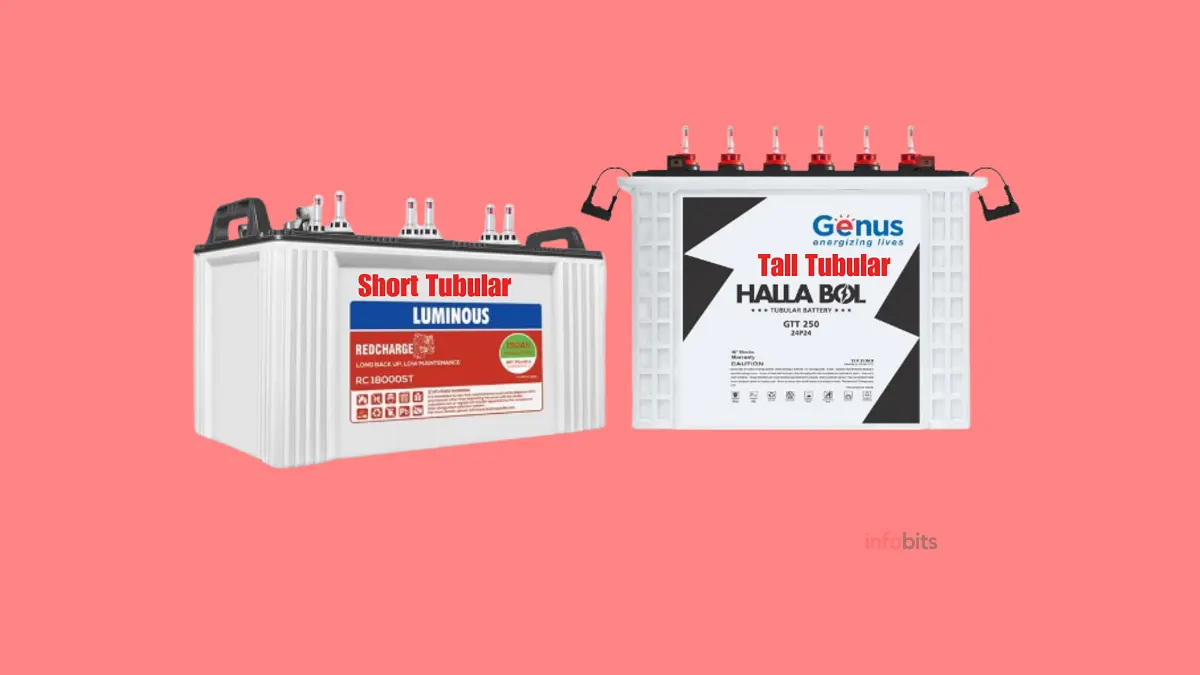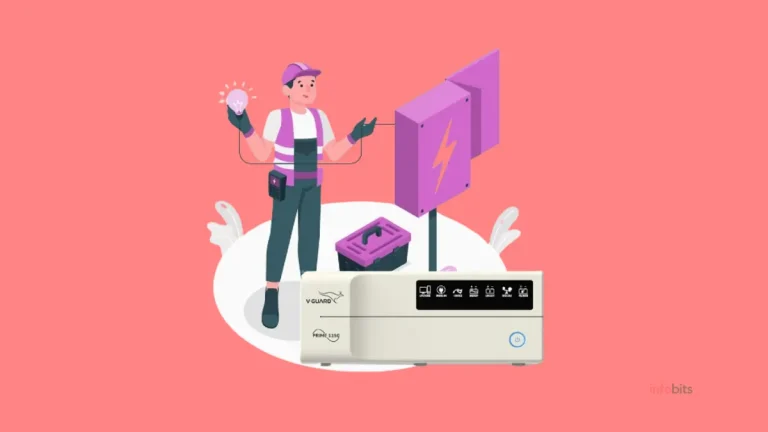Difference Between Short Tubular and Tall Tubular Batteries
A considerable advancement over conventional flat-plate batteries may be seen in the field of energy storage systems with tubular batteries.
They not only have improved longevity and efficiency, but they also come in a range of sizes and designs to meet a wide range of power requirements.
Among them, short- and long or tall-tubular batteries are particularly popular, and it might be quite important for consumers and business experts to know how they differ from one another.
This article explores the fundamental differences between long tubular and short tubular batteries, describing their uses, operating principles, architectures, and important differences.
Short Tubular Battery: Overview
Structure of Short Tubular Battery
The compact design of the short tubular battery, which consists of many tubular-positive plates, makes it unique.
The active ingredient is contained in shields that resemble fabric and are secured in place by tubular bags. Compared to flat-plate batteries, the design offers better current efficiency and is tuned to minimize shedding and prolong battery life.
Strong materials that can tolerate repeated deep discharges are frequently used in the construction of these batteries.
Because of its modest size and compact design, it is a good fit for situations where there is space constraint.
They are designed to work dependably despite their small size, with an emphasis on low maintenance and endurance.
Working Principle of Short Tubular Battery
The basic idea behind how other lead-acid batteries function also applies to short tubular batteries.
Through interactions between the sulfuric acid electrolyte, sponge lead negative plates, and lead dioxide positive plates, chemical energy is transformed into electrical energy in their electrochemical process.
When discharging, the sponge lead oxidizes to lead sulfate on the negative plate, and the lead dioxide on the positive plate reduces to lead sulfate, releasing electrons that power the electricity.
When the lead sulfate is recharged, the process is reversed, and it turns back into lead dioxide and sponge lead, respectively.
The positive plate’s distinctive tubular form offers more surface area, which boosts electrochemical processes and improves the efficiency of charge and discharge cycles by better using the active material.
Applications and Uses of Short Tubular Battery
Short tubular batteries are used in areas that demand space-saving solutions while maintaining the required battery capacity.
These batteries are commonly used in renewable energy systems such as solar and wind power storage, uninterruptible power supply (UPS) systems, and inverter batteries for home and small office applications.
They are also widely used in the telecommunications industry, where system equipment demands small, high-efficiency power sources with predictable discharge characteristics.
Short tubular batteries are also chosen in areas with restricted maintenance access since they require less care and can provide constant performance over a long period.
They are a popular choice for distant sites and areas with inconsistent power supplies, as they provide a buffer against power interruptions and fluctuations.
Long Tubular Battery: Overview
Structure of Long Tubular Battery
The tall tubular battery is differentiated by its extended tubular plates, which have a higher surface area than its shorter tubular equivalent.
The larger size of the positive plates, contained in tubular shields, allows for more active material, resulting in better energy capacity and longer backup durations.
The construction is designed to reduce positive plate shedding, which effectively increases the battery’s service life.
Long tubular batteries are built to last and are often stronger than short tubular batteries, making them ideal for applications that require longer power backup and repeated deep cycles.
The bigger physical size, however, implies that they take up more room and may not be suited for small installations.
Working Principle of Long Tubular Battery
Long tubular batteries, like the short tubular form, use lead-acid chemistry. They store and release energy via interactions between lead-based plates and sulfuric acid electrolytes.
The enlarged shape of their tubular positive plates gives them a larger active surface area, allowing for faster electrochemical reactions and energy transfer during charging and discharging.
The lifespan of the battery is significantly increased since the huge surface area decreases stress on individual battery components, especially during high-load operations.
This implies that long tubular batteries are particularly good at dealing with extended power outages and are commonly employed in systems that require stable, long-duration power backup.
Applications and Uses of Long Tubular Battery
Long tubular batteries are widely used in heavy-duty applications such as industrial power backup systems, big solar power installations, and off-grid energy storage solutions.
They are ideal for places with frequent power outages or projects with high and consistent energy demands.
Furthermore, these batteries are used in industries such as telecommunications and data centres, where reliable, long-lasting power is required for the operation of sensitive equipment.
Long tubular batteries’ dependability and longevity make them an excellent choice for distant areas where maintenance is rare but performance requirements are high.
Key Differences Between Short and Long Tubular Batteries
Difference in Structure
The most obvious distinction between short and long tubular batteries is their size and plate construction.
Short tubular batteries have a more compact construction, making them ideal for limited locations and low-demand applications. The smaller tubular plates fit into narrower spaces and deliver plenty of power for their size.
Long tubular batteries, on the other hand, have bigger plates that can house more active material, allowing them to store more energy.
This design is useful for applications that require longer backup power and is more durable enough to withstand several deep discharge cycles.
Difference in Working Principle
While both types of batteries use lead-acid chemistry, the size and shape of their tubular plates influence energy storage and release dynamics.
Because of their small dimensions, short tubular batteries may charge and discharge more quickly, which might be useful in applications requiring brief energy bursts.
Long tubular batteries, with their bigger plates, are designed for extended periods of energy storage.
Their construction is designed to retain performance over long periods, which is critical for systems that experience frequent power outages or require continuous power supply for longer periods.
Difference in Capacity and Performance
The capacity and performance of a battery are important concerns, and these characteristics change dramatically between short and long tubular batteries.
Short tubular batteries often have a lesser capacity, making them ideal for less energy-intensive applications. They compensate with a smaller size and faster recharge capabilities, which are desirable in some applications.
Long tubular batteries, on the other hand, have a higher capacity because of their bigger size and more active material. This correlates to longer backup durations and a greater capacity to tolerate deep discharge cycles, resulting in more consistent power over longer periods.
However, their increased size may prove to be a disadvantage in situations where space is a problem.
Choosing the Right Battery: Factors to Consider
Evaluating Energy Needs
When deciding between short- and long-tubular batteries, the first step is to consider your energy requirements.
Understanding your system’s power requirements, especially peak loads and use patterns, is crucial.
For example, a short tubular battery may be sufficient for a household UPS system, but a long tubular battery may be required for an industrial application with larger energy needs.
It is critical to examine both immediate and future energy requirements to ensure that the battery chosen can manage the predicted power consumption and allow for scalability if necessary.
Considering Physical Space and Installation
Physical restrictions have a considerable impact on battery choices.
Short tubular batteries are more compact and can be used in tight places or when a lighter-weight option is needed. Installation conveniences, such as simplicity of battery replacement or integration into an existing system, should also be considered.
Long tubular batteries may be a preferable alternative in situations with appropriate space to accommodate bigger batteries, especially when long-term power endurance is required.
Installation of large batteries may need extra planning owing to their size and weight, which must be addressed throughout the decision-making process.
Accounting for Cost and Maintenance
Cost is an important consideration, not just for the original investment but also for long-term maintenance and running expenditures.
Short tubular batteries may be less expensive in the beginning, but depending on the application, the total cost of ownership might be greater if frequent replacements are necessary.
Long tubular batteries, on the other hand, may be more expensive at first but become more cost-effective over time due to their longevity and low maintenance requirements.
When picking between the two types of batteries, consider both the purchase price and the expected lifespan expenses.
Advancements in Battery Technology
Improvements in Short Tubular Batteries
Recent breakthroughs in battery technology have resulted in considerable improvements to short tubular batteries.
Manufacturers have focused on increasing the capacity and efficiency of these batteries while keeping them small.
Plate composition and electrolyte formulation improvements have resulted in increased energy densities and improved charge retention, making these batteries more competitive in a wider variety of applications.
Furthermore, efforts are being undertaken to increase the sustainability and recyclability of short tubular batteries, in line with rising environmental consciousness and the demand for eco-friendly energy storage options.
Improvements in Long Tubular Batteries
Long tubular batteries have also benefited from technical advancements. They have found increases in lifetime and the capacity to resist deeper discharge cycles.
Breakthroughs in materials engineering have resulted in more durable plate designs, which contribute to longer battery service life and lower maintenance needs.
New electrolyte additives and advanced battery management systems have been created to boost performance, further strengthening the position of long tubular batteries in sectors that require long-term, stable power.
Future Trends and Predictions
Looking ahead, the battery business has been prepared for more innovation. As research into new materials and technologies advances, we should expect to see even more advancements in both short- and long-tubular batteries.
Lithium-based alternatives and other developing chemicals are expected to have an impact on the development of tubular batteries, perhaps providing bigger capacity, faster charging times, and even longer life.
There is also a major push to incorporate smart technology into battery systems, enabling real-time monitoring, predictive maintenance, and adaptive performance management.
Such developments will not only improve the user experience but also the overall efficiency and robustness of energy storage systems.
Short and Tall Batteries: Conclusion
As previously discussed, short- and long-tubular batteries have distinct characteristics that make them useful for a variety of applications.
Choosing the correct battery necessitates careful consideration of energy requirements, physical space, installation requirements, and budgetary limits.
With continuous technical improvements, the distinction between these two types of batteries is expected to grow more complex, providing customers with a larger range of options to satisfy their power requirements.
As time goes on, staying up-to-date on the newest breakthroughs in battery technology will be crucial for making educated judgments on dependable, efficient, and sustainable energy storage solutions.
We hope you are interested in our articles and consider following our Facebook, Instagram, and Twitter pages for regular updates.
Subscribe to our free newsletter to get similar articles and regular updates directly in your Email Inbox.
Also, share this article with your friends and relatives. Bookmark this page for future reference.
You May Be Interested to Read:
- How to Charge the Inverter/UPS Battery Efficiently?
- How to Select the Right Inverter and Battery for Home in India?
- Comparing C10 vs C20 Batteries for Inverters: Which One is Good?
- The Ultimate Guide to Lead Acid Battery BMS: Everything You Need to Know
- How to Fix the Inverter Overload Problem Efficiently?







